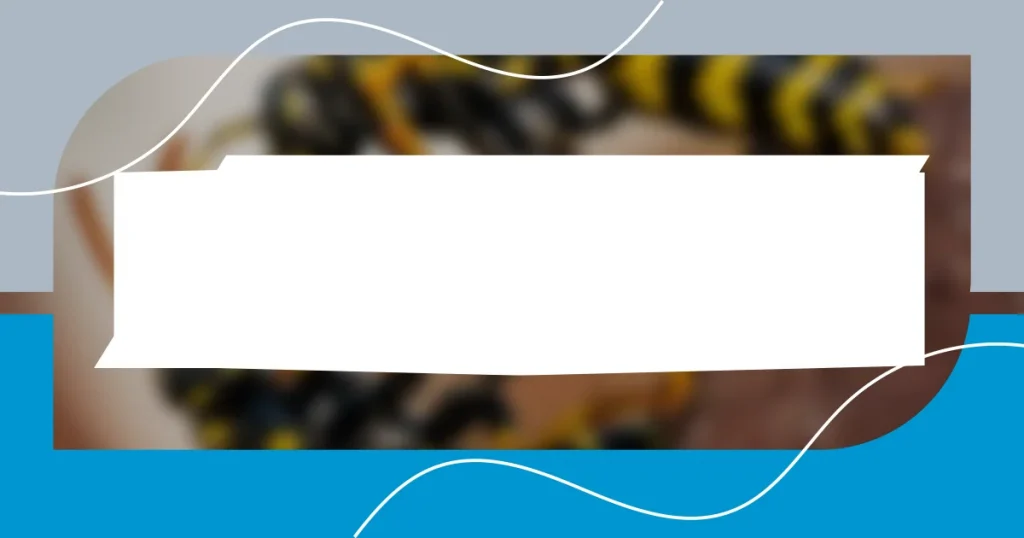Key takeaways:
- Utilizing various hazard identification methods, such as safety audits and team input, enhances the recognition of risks and fosters a culture of shared responsibility.
- Implementing effective tools like mobile apps for real-time reporting, hazard mapping, and training simulations improves team awareness and preparedness for potential hazards.
- Continuous improvement through regular updates, engaging diverse stakeholders, and incorporating feedback loops is essential for maintaining an effective hazard identification plan.

Understanding hazard identification methods
When I think about hazard identification methods, I remember my first day on a site visit. Armed with a clipboard and a fresh cup of coffee, I quickly realized that each method—whether it’s a checklist, a brainstorming session, or a thorough walkthrough—provides a unique lens to view potential risks. Isn’t it fascinating how one method might reveal hazards that another could overlook?
I often find myself leaning toward safety audits, as they allow for a systematic examination of the workspace. During one audit, I spotted an unsecured ladder, and I can’t tell you how relieved I felt to address that risk before anyone got hurt. Have you ever had a moment like that where a simple check made all the difference?
Relying on input from team members is equally important, as it fosters a culture of safety and shared responsibility. One time, a colleague pointed out a minor issue that I had completely missed. It underscored for me that hazard identification isn’t just about processes; it’s about people working together to create a safe environment. How do you incorporate team input in your own hazard identification practices?

Tools for identifying workplace hazards
Tools play a critical role in the process of identifying workplace hazards. I’ve come to appreciate the effectiveness of digital platforms like mobile apps that enable real-time reporting of hazards. I remember using one during a warehouse visit; an instant notification allowed the team to address a potential safety issue almost immediately. Have you explored similar tools that offer swift communication?
Another tool I highly recommend is the use of visualization techniques, such as hazard mapping. A few years ago, I participated in a workshop where we created detailed maps of our work area, highlighting potential hazards. It was eye-opening to see the layout visually and recognize patterns we might have missed during standard assessments. Has a visual representation ever helped you grasp the risks better?
Additionally, training sessions and simulations are essential for hazard identification. I once took part in a mock emergency drill, which opened my eyes to how quickly risks can escalate under pressure. The experience not only highlighted potential hazards but also reinforced the importance of preparedness and teamwork in maintaining safety. Have you had the chance to engage in practical training that sharpened your hazard identification skills?
| Tool | Description |
|---|---|
| Mobile Apps | Real-time reporting for immediate hazard notifications. |
| Hazard Mapping | Visual techniques to identify and analyze potential risks. |
| Training Simulations | Practical drills to enhance awareness and preparedness. |

Engaging employees in hazard identification
Engaging employees in hazard identification is essential for fostering a culture of safety. I fondly remember a safety meeting where we gathered in a circle to discuss potential risks. Everyone shared their experiences, and it was remarkable to witness how one person’s story about a near-miss incident sparked a flurry of ideas and suggestions from the rest of the team. It really drove home the point that safety isn’t just a checklist; it’s about open communication and shared awareness.
To effectively involve employees, consider implementing these strategies:
- Open Dialogue: Encourage team members to voice their observations without the fear of judgment. This can lead to invaluable insights.
- Regular Workshops: Organize interactive sessions where employees can brainstorm and role-play different scenarios.
- Recognition Programs: Acknowledge and reward those who identify hazards, reinforcing positive behavior and active participation.
- Feedback Loop: Create a system where employees can share feedback on safety measures and report hazards easily.
When I started embracing these practices, I noticed a shift in team dynamics—a collective responsibility for safety that wasn’t there before. It felt empowering to see everyone take ownership, as if we were all guardians looking out for one another. Have you seen that kind of transformation in your workplace?

Conducting a successful hazard assessment
Conducting a successful hazard assessment requires a structured approach, which I’ve found is best initiated with a thorough walkthrough of the site. During one assessment, I noticed a section of the floor that was consistently wet, an overlooked hazard that could lead to slips and falls. It made me realize how crucial it is to observe not just for obvious dangers but also for conditions that could evolve into risks. Have you ever found something unexpected during a routine check?
Next, involving employees in the assessment process has provided me with invaluable insights. One time, I invited team members to share their concerns and experiences during a casual team lunch. They pointed out areas I hadn’t even considered, like cramped spaces that could hinder evacuation in an emergency. This collective input highlighted that hazard assessment truly benefits from diverse perspectives. Have you tapped into the wisdom of your team during assessments?
Lastly, I’ve learned that documenting findings and following up on corrective actions is vital for a successful hazard assessment. In one case, I noted several issues, but it was following up weeks later that truly reinforced accountability. I was pleasantly surprised to see how addressing past concerns actually improved our safety culture. How do you keep track of issues once they’re identified to ensure they’re resolved effectively?

Creating a hazard identification plan
Creating a hazard identification plan requires a clear understanding of the specific risks faced by your workplace. I remember drafting my first plan, and it felt like piecing together a puzzle. Each identified hazard needed to be meticulously categorized, ensuring that nothing slipped through the cracks. I found using a simple matrix of likelihood versus severity helped visualize the most pressing concerns. Have you ever tried prioritizing hazards this way?
A crucial step in my experience is constantly reviewing and updating the plan. I didn’t think much about it initially until a near-miss incident made it glaringly apparent. The need for real-time updates became clear. Engaging my team in this process transformed what felt like a chore into a collaborative effort. We regularly scheduled review sessions, and I noticed how revisiting the plan kept safety at the forefront of our minds. How often do you revisit your plans to ensure they’re current?
Additionally, I learned that involving various stakeholders when creating the plan adds depth to hazard identification. Once, I organized a brainstorming session with colleagues from different departments, and it opened my eyes to hazards I hadn’t considered—like ergonomic risks in our office layout. Their firsthand experiences were invaluable and made the plan more comprehensive. Isn’t it interesting how different perspectives can shed light on unseen dangers?

Continuous improvement in hazard identification
To me, continuous improvement in hazard identification means always being on the lookout for new ways to enhance safety. I recently took part in a workshop focused on innovative hazard identification techniques that really opened my eyes. Learning about new technologies, like digital checklists and reporting apps, energized me and showed me how these tools could streamline our processes. Have you ever felt inspired to change your approach after an engaging discussion?
In my experience, regular training sessions play a pivotal role in fostering a culture of continuous improvement. I made it a point to hold quarterly refresher courses, and each time, we had lively discussions that revealed gaps in our understanding. Once, a participant shared a story about a close call with machinery that led to an intense conversation about preventive measures. It struck me how sharing real experiences can elevate awareness and drive home the importance of staying current with safety procedures. Have you included storytelling in your training sessions for added impact?
Additionally, I’ve found that creating a feedback loop is essential to ensure that the hazard identification process remains fluid and effective. One approach that worked wonders for me was an anonymous suggestion box where team members could voice concerns or propose improvements. It was surprising to see how candidly they spoke up, especially about issues that could have easily gone unnoticed. This open dialogue not only led to actionable insights but also fostered a sense of ownership in our safety culture. How do you encourage feedback in your organization to ensure continuous improvement?
















